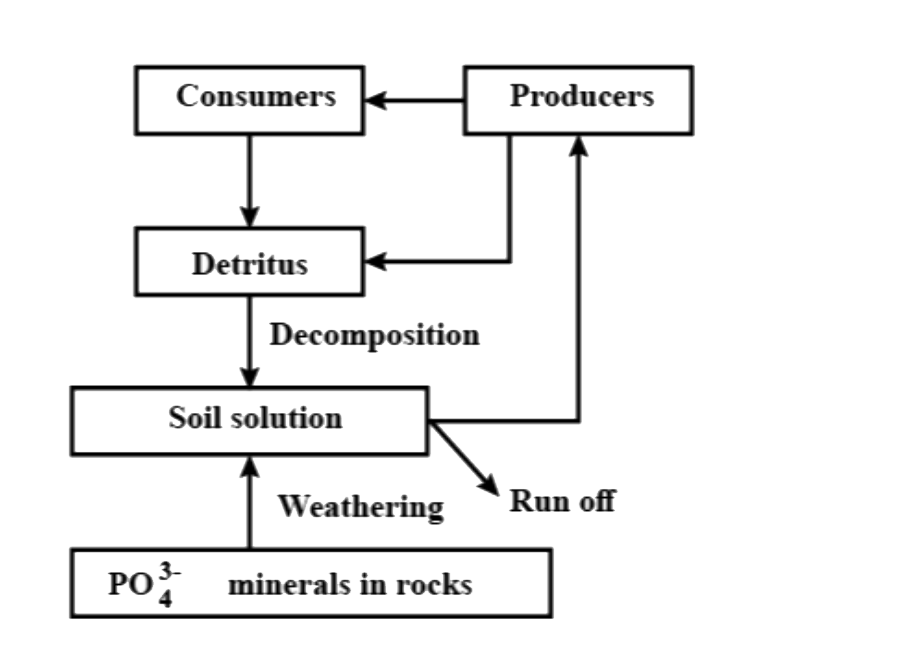Select the CORRECT match.
(a) Sedimentary cycle - Nitrogen cycle
(b) Guano deposit - phosphorus cycle
(c) Lithosphere - Reservoir pool of carbon
(d) Quercus - Species of woodland stage
Sedimentary cycle - Nitrogen cycle
Guano deposit - phosphorus cycle
Lithosphere - Reservoir pool of carbon
Quercus - Species of woodland stage
The correct Answer is:B
To solve the question, we need to evaluate each option and determine which one is a correct match.
1. Option (a): Sedimentary cycle - Nitrogen cycle
- The sedimentary cycle refers to the movement of nutrients through the earth's lithosphere, hydrosphere, and biosphere, typically involving elements like phosphorus and sulfur. The nitrogen cycle, however, is a gaseous cycle that involves the transformation of nitrogen in various forms.
- Conclusion: This is not a correct match.
2. Option (b): Guano deposit - Phosphorus cycle
- Guano deposits are accumulations of bird excrement, which are rich in nutrients, particularly phosphorus. These deposits are often used as a fertilizer and are a significant source of phosphorus in ecosystems.
- Conclusion: This is a correct match.
3. Option (c): Lithosphere - Reservoir pool of carbon
- The lithosphere refers to the rigid outer layer of the Earth, which includes the crust and upper mantle. While it does contain carbon in various forms (like fossil fuels), it is primarily known as a reservoir for phosphorus rather than carbon.
- Conclusion: This is not a correct match.
4. Option (d): Quercus - Species of woodland stage
- Quercus is the genus that includes oak trees, which are commonly found in temperate deciduous forests. While they can be part of woodland ecosystems, they are not specifically classified as a "species of woodland stage."
- Conclusion: This is not a correct match.
Final Answer:
The only correct match is (b) Guano deposit - phosphorus cycle.
---
- The sedimentary cycle refers to the movement of nutrients through the earth's lithosphere, hydrosphere, and biosphere, typically involving elements like phosphorus and sulfur. The nitrogen cycle, however, is a gaseous cycle that involves the transformation of nitrogen in various forms.
- Conclusion: This is not a correct match.
- Guano deposits are accumulations of bird excrement, which are rich in nutrients, particularly phosphorus. These deposits are often used as a fertilizer and are a significant source of phosphorus in ecosystems.
- Conclusion: This is a correct match.
- The lithosphere refers to the rigid outer layer of the Earth, which includes the crust and upper mantle. While it does contain carbon in various forms (like fossil fuels), it is primarily known as a reservoir for phosphorus rather than carbon.
- Conclusion: This is not a correct match.
- Quercus is the genus that includes oak trees, which are commonly found in temperate deciduous forests. While they can be part of woodland ecosystems, they are not specifically classified as a "species of woodland stage."
- Conclusion: This is not a correct match.
The only correct match is (b) Guano deposit - phosphorus cycle.
Similar Questions
Knowledge Check
Select the pairs of sediamentary biogeochemical cycles.
I. Hydrogen cycle and water cycle
II. Phosphorus cycle and sulphur cycle
III. Calcium cycle and magnesium cycle
IV. Carbon cycle and nitrogen cycleAI and IIBII and IIICIII and IVDI and IVRead the following statements and select the incorrect ones.
(i) The co-ordinated activities of the legume and Rhizobium bacteria depend on chemical interactions between the symbiotic partners.
(ii) Leguminous roots secrete chemical attractants that attract Rhizobium bacteria living nearby.
(iii) N, P and K usually do not get deficient in soil due to their low plant requirement
(iv) Nitrogen cycle is regular circulation of nitrogen amongst living organisms with its reservoir pool in lithosphere and cycling pool in atmosphere.A(i) and (ii)B(ii) and (iii)C(iii) and (iv)D(ii), (iii) and (iv)
Select the wrongly matched pair with regard to the C4 cycle.
View SolutionThe diagram/flow chart represents which of the sedimentary biogeochemical cycle ?

(a) Nitrogen cycle
(b) Phosphorus cycle
(c) Oxygen cycle
(d) Sulphur cycle
View SolutionSelect the correct match for C4 cycle —
View Solution
Identify A, B, C, D in above cycle.
View Solution(a) Trace the succession of plants on a dry bare rock.
(b) How does phosphorus cycle differ from carbon cycle. ?
View SolutionWhich ones are reservoirs of Phosphorus and Nitrogen cycles respectively
View Solution
